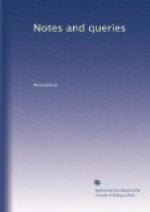“Vers l’est de cette Isle il y a une petite plaine au haut d’une montagne, qu’on appelle la Plaine des Caffres, ou l’on trouve un gros oiseau bleu, dont la couleur est fort eclatante. Il ressemble a un pigeon ramier; il vole rarement, et toujours en rasant la terre, mais il marche avec une vitesse surprenante; les habitans ne lui ont point encore donne d’autre nom que celui d’oiseau bleu; sa chair est assez bonne et se conserve longtemps.”
Not a word, however, about the Dodo, which had it then existed there, would certainly have been noticed by the observant Jesuit. But now for the bat:—
“La chauve-souris est ici de la grosseur d’une poule. Cet oiseau ne vit que de fruits et de grains, et c’est un mets fort commun dans le pays. J’avois de la repugnance a suivre l’exemple de ceux qui en mangeoient; mais en ayant goute par surprise, j’en trouvai la chair fort delicate. On peut dire que cet animal, qu’on abhorre naturellement, n’a rien de mauvais que la figure.”
The Italics are mine; but they serve to show how the confusion has arisen. The writer speaks of the almost entire extinction of the land Turtles, which were formerly abundant; and says, that the island was well stocked with goats and wild hogs, but for some time they had retreated to the mountains, where no one dared venture to wage war upon them.
Again, in the Voyage de l’Arabie Heureuse par l’Ocean Oriental et le Detroit de la Mer rouge, dans les Annees 1708-10 (Paris, 1716, 12mo.), the vessels visit both Mauritius and Bourbon, and some account of the then state of both islands is given. At the Mauritius, one of the captains relates that, foraging for provisions,—
“Toute notre chasse se borna a quelques pigeons rougeatres, que nous tuames, et qui se laissent tellement approcher, qu’on peut les assommer a coup de pierres. Je tuai aussi deux chauve-souris d’une espece particuliere, de couleur violette, avec de petites taches jaunes, ayant une espece de crampon aux ailes, par ou cet oiseau se pend aux branches des arbres, et un bec de perroquet. Les Hollandois disent qu’elles sont bonnes a manger; et qu’en certaine saison, elles valent bien nos becasses.”
At Bourbon, he says,—
“On y voit grandes nombres d’oiseau
bleu qui se
nichent dans les herbes et dans les fougeres.”
This was in the year 1710. There were then, he says, not more than forty Dutch settlers on the Island of Mauritius, and they were daily hoping and expecting to be transferred to Batavia. As editor (La Roque) subjoins a relation furnished on the authority of M. de Vilers, who had been governor there for the India Company, in which it is said,— {354}




